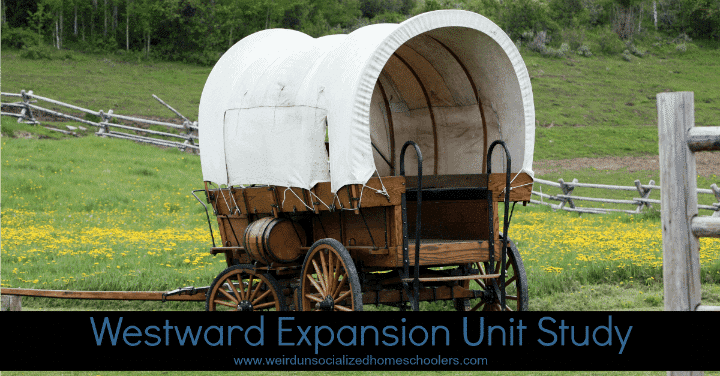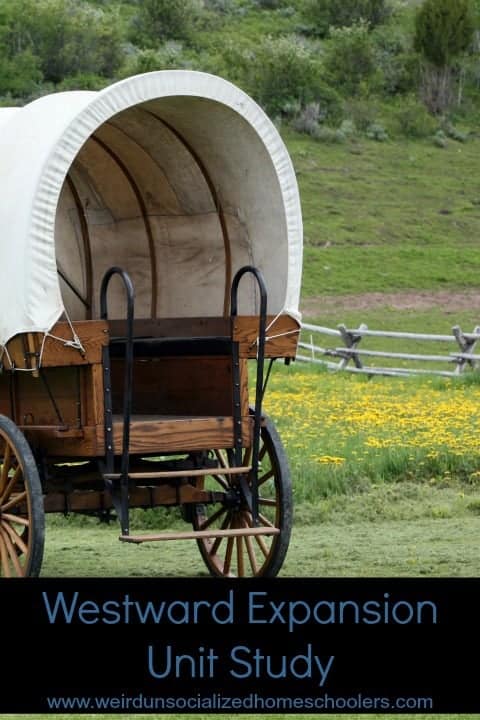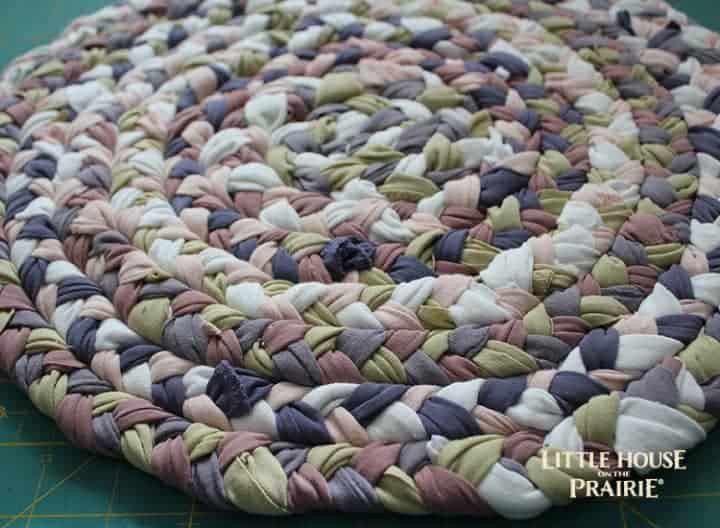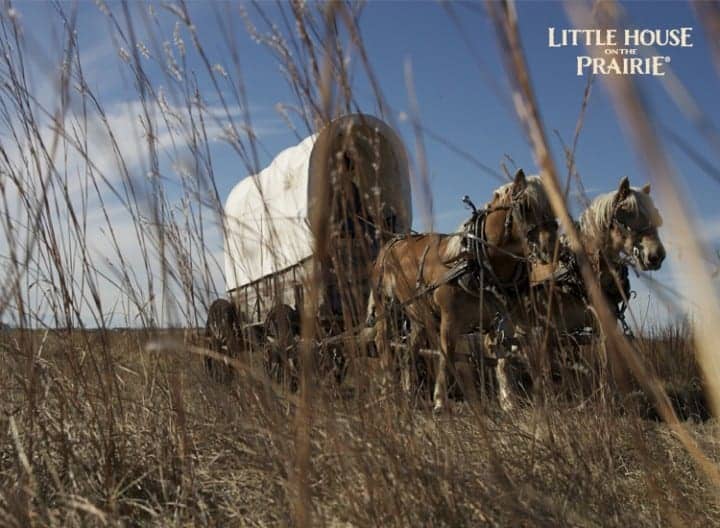Westward Expansion Unit Study
This post was originally published on April 26, 2006. It has been updated and expanded, including a brand-new resource that will excite Little House on the Prairie fans – Little House on the Prairie: The Legacy of Laura Ingalls Wilder, a one-hour documentary about the real Laura Ingalls Wilder, directed and narrated by Dean Butler, who played Almanzo Wilder on the popular television series.

The first several years we homeschooled, we used unit studies exclusively. I usually wrote them myself. Looking back over the original text of this post, it’s funny to me how many important concepts of writing unit studies I had already figured out.
Three of the most important concepts about writing unit studies that I’d already learned were:
- Look for ready-made units that can be adapted to fit your family or that will provide a springboard for ideas.
- Limit read-aloud/independent reading to two good books – one biography and one historical fiction or quality literature set in the time period you’re studying.
- Limit activities to a few quality projects.
Westward Expansion Unit Study
These ideas are intended to be a simple roadmap to guide your study, not a cram-packed agenda destined to be a source of frustration. I would typically allow 6-8 weeks per unit study.
I like to read the two read-aloud books a little each day, so I divide the number of pages in each by the number of days we’ll be reading. For a 6 week study, I divided by 24, which leaves one day per week to catch up if we get behind.
For the activities, I suggest choosing 2-3 per day unless they are very involved activities that may take more time. This unit was written for my 10 year old girl, 6 year old boy, and 4 year old girl with the majority geared toward the oldest and activities to include the younger siblings.
Read-aloud/Independent reading
- Girl of the shining mountains: Sacagawea’s story / Peter & Connie Roop
- Little House on the Prairie / by Laura Ingalls Wilder
Learning Resources
These resources should be used as a guide. Don’t overwhelm yourself or your children by attempting to read each book in its entirety or to even read each book listed. Choose the ones that are appealing to your family and cover the topics that you’d like to include from the learning activity ideas.
- The Prairie Primer by Margie Gray (Use as a resource for Little House on the Prairie study and activities.)
- Everything You Need to Know About American History Homework: A Desk Reference for Student and Parents, by Anne Zeman and Kate Kelly
- Little House on the Prairie: The Legacy of Laura Ingalls Wilder (Use coupon code LHSCHOOL to save 20% when ordering from Amazon. Offer expires 12/1/15.)
- Lewis and Clark for kids: their journey of discovery with 21 activities / Janis Herbert
- Lewis and Clark and me: a dog’s tale / Laurie Myers (I highly recommend this one!)
- The Amazing Impossible Erie Canal / by Cheryl Harness
- All Aboard!: a true train story / words and photographs by Susan Kuklin
- Full Steam Ahead / by Faye Gibbons
- The Sweetwater Run: the Story of Buffalo Bill Cody and the Pony Express / Andrew Glass
- Pony Express! / by Steven Kroll
- Gold fever / Verla Kay
- Gold fever!: tales from the California gold rush / Rosalyn Schanzer
- Soft Rain: a story of the Cherokee Trail of Tears / Cornelia Corneissen
- Any books from the Simple Machine series by David Glover
Activities
As with the learning resources, use the following as a guide. Some are quick and simple activities that can be completed in one sitting, while others will be completed over the course of the unit.
Keep an on-going list of new vocabulary words learned during the unit.
Start a Presidents notebook including all the United States presidents through the 1800’s. Try to memorize them, in order, as you learn about each. Younger students may enjoy completing a U.S. Presidents coloring page.
Complete a U.S. states notebook, including all the states in the union through this point in history. These United States coloring pages are our favorites! Memorize states and present-day capitals.
Learn about birds and animals. The explorers and settlers of the American west encountered many animals, birds, and plants that they’d never seen before, as you can see in this interactive Lewis and Clark journal. Learn about some of the different types of animals and birds they may have seen for the first time. Make a notebook including drawings and descriptions of some of these animals, birds and plants, or be an explorer in your own backyard and make a notebook of your own discoveries.
Start a nature journal. Learn about the types of trees in your area. Find out the names of at least three trees. Draw pictures of the trees, their leaves, and their seeds. Collect leaves from each and include in your nature journal. What are some of the uses of these trees?
Learn about the pioneers. The early pioneers made most of what they needed by hand. Learn how to make a braided rug like Mary Ingalls did in The Long Winter or learn how to make your own ink and envelopes. Watch Little House on the Prairie: The Legacy of Laura Ingalls Wilder (Use coupon code LHSCHOOL to save 20% when ordering from Amazon. Offer expires 12/1/15.) to learn more about the life of Laura Ingalls Wilder.
image used with permission of Little House on The Prairie
Learn about the Pony Express. The Pony Express delivered mail between St. Joseph, Missouri and Sacramento, California in 1860 and 1861. Learn about how the Pony Express worked. Role-play a Pony Express mail delivery. Discuss the differences in the Pony Express and how we receive our mail today.
Learn about the Erie Canal. What is a canal? The Erie Canal was started in 1817 and finished in 1825. It was 360 miles long and made it possible to travel by boat from the Great Lakes to the Atlantic Ocean. Learn more about how the Erie Canal was built. Learn the names and locations of the Great Lakes. Color them on a blank map.
Learn about trains. The first locomotive built in the United States went into service on Dec. 25, 1830. On July 1, 1862, Abraham Lincoln signed the Pacific Railroad Act, which called for building a railroad from Omaha, Nebraska to Sacramento California. Learn more about the trains and railroads of the United States.
Study the Gold Rush. In 1848, gold was discovered in California. When news reached the east coast, thousands of people moved to California in hopes of striking it rich. Learn about the California Gold Rush. Make your own “gold nuggets” by painting pebbles with gold spray paint and pretend to mine for gold or visit somewhere that offers a gem panning experience, such at the Tellus Science Museum. Make your own Gold Rush game to play.
Make a notebooking page for some of the interesting facts you learn. For example, Levi Strauss invented the first blue jeans, sold to California gold miners.
Make a corn husk doll. Corn husk dolls were very popular in the early days of American settlement. Follow this how to make a corn husk doll tutorial to make one with your kids.
Learn about the forced resettlement of Native Americans. During the mid-1800’s, the United States government forced all Native American tribes, most of whom had already been forced from their land, to move onto reservations. Learn more about the resettlement of these Native American tribes. We studied the Cherokee, who lived in our area. You may choose to learn more about the Native Americans who lived in your part of the country.
Learn about simple machines. American settlers used many simple machines, such as the plow, in farming and settling their land. Learn about some of these simple machines. Try making and using some of your own.
Learn about fire safety. In Little House on the Prairie, the family has to deal with a prairie fire. Discuss fire safety for your family. If you’re doing your study in early October, check with area fire stations to see if they are offering any special programs for Fire Prevention Week.
image used with permission of Little House on The Prairie
Learn more from Little House on the Prairie. In Little House on the Prairie, Mary and Laura contract malaria. What is malaria? What causes it? What are its symptoms? At one point, the girls encounter a snake. Learn how to tell the difference between poisonous and non-poisonous snakes. Discuss what you should do if you encounter a snake. Take a trip to a zoo or nature center to learn more about the snakes common to your area. Build a log cabin, using Lincoln logs, pretzels, or craft sticks.
Field Trips
Consider some of the following field trip destinations.
- A state park (particularly if there is one with cabins similar to those Laura Ingall’s family would have lived in)
- Zoo or nature center
- Fire station
- Railroad museum or train station
- Post office
- Ingalls family sites – Check to see if you live near any of the actual Little House on the Prairie historic sites and locations. If you do, please visit on our behalf!
This post is linked to the Hip Homeschool Hop.
covered wagon images courtesy of depositphotos
Kris Bales is a newly-retired homeschool mom and the quirky, Christ-following, painfully honest founder (and former owner) of Weird, Unsocialized Homeschoolers. She has a pretty serious addiction to sweet tea and Words with Friends. Kris and her husband of over 30 years are parents to three amazing homeschool grads. They share their home with three dogs, two cats, a ball python, a bearded dragon, and seven birds.






This is so timely for us, as I just wrote up a Little House unit study yesterday, and I’m very new at writing my own unit studies. That’s great advice about the books. As a book fanatic myself, I can get caught up in assigning or planning to read aloud too many books. Thanks for the reminder. We’ll only have about three weeks for this, so I’m using The World of Little House as the springboard for all of the activities, and this is one of the two books I’ll be reading aloud. (The other is The Little House Christmas Treasury.) The kids will each be reading a biography about Laura on their own. You gave me so many ideas that I’ll never have time for in three weeks, but I may plan a longer unit study to incorporate these later in the year. Great post!
Yeah, I’m the queen of coming up with more ideas than we’ll ever have time for. I just think of it as a buffet – we’ll have fun choosing until our plates are full. 🙂